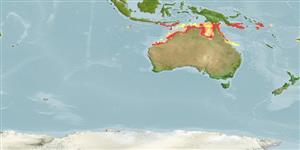Environment: milieu / climate zone / depth range / distribution range
Ecologie
marien benthopelagisch, usually 8 - 10 m (Ref. 27621). Tropical; 9°S - 21°S
Western Pacific: northern Australia. Almost certainly present in southern Papua New Guinea.
Grootte / Gewicht / Leeftijd
Maturity: Lm ? range ? - ? cm
Max length : 32.0 cm TL mannelijk / geslacht onbekend; (Ref. 3132); common length : 20.0 cm TL mannelijk / geslacht onbekend; (Ref. 27621)
Dorsale stekels (totaal): 8; Dorsale zachte stralen (totaal): 14; Anale stekels 3; Anale zachte stralen: 12. Three dark vertical bands from nape, the first through eye, the second along the edge of the preopercle and the third down to the base of the pectoral fins; Dorsal fin with 8 spines increasing in length from a small anterior spine to a long posterior one; soft dorsal rays 14, much higher than spinous part and with the anterior ray produced into a short filament, the third ray prolonged into a long simple filament which extends past the caudal fin and the fourth and fifth rays also extended to beyond the hypural joint; anal fin with 3 slender spines and 12 soft rays, the second ray prolonged beyond the caudal fin and the third ray almost as long in small specimens.
Inhabit trawling grounds. Found more frequently in moderate depths on the continental shelf particularly close to submerged reefs or rough bottom (Ref. 27621). Feed mainly on crustaceans (Ref. 27621). Some cuttlefish are also taken (Ref. 27621).
Levenscyclus en paargedrag
Maturiteit | Voortplanting | Paaien | Eieren | Fecunditeit | Larven
McKay, R.J., 1997. FAO Species Catalogue. Vol. 17. Pearl perches of the world (family Glaucosomatidae). An annotated and illustrated catalogue of the pearl peches known to date. FAO Fish. Synop. 125(17):26p. Rome: FAO. (Ref. 27621)
Status op de Rode Lijst van het IUCN (Ref. 130435)
Gevaar voor de mens
Harmless
Gebruik door de mens
Visserij: van minder commercieel belang
Meer informatie
Lokale namenSynoniemenMetabolismePredatorenEcotoxicologieVoortplantingMaturiteitPaaienPaaiaggregatiesFecunditeitEierenOntwikkeling van de eieren
ReferentiesAquacultuurAquacultuurprofielKweeklijnenGeneticaElectrophoresesErfelijkheidZiektesVerwerkingNutrientsMassaconversie
Tools
Speciale rapporten
Download XML
Internetbronnen
Estimates based on models
Preferred temperature (Ref.
123201): 26.7 - 28.8, mean 28 °C (based on 505 cells).
Fylogenetische diversiteitsindex (Ref.
82804): PD
50 = 0.6250 [Uniqueness, from 0.5 = low to 2.0 = high].
Bayesian length-weight: a=0.01995 (0.00906 - 0.04395), b=3.01 (2.83 - 3.19), in cm total length, based on all LWR estimates for this body shape (Ref.
93245).
Trofisch niveau (Ref.
69278): 4.1 ±0.48 se; based on food items.
Weerstandsvermogen (Ref.
120179): Gemiddeld, minimale populatieverdubbelingstijd 1,4-4,4 jaar (Preliminary K or Fecundity.).
Fishing Vulnerability (Ref.
59153): Low vulnerability (22 of 100).
Nutrients (Ref.
124155): Calcium = 89.3 [49.7, 187.5] mg/100g; Iron = 0.754 [0.431, 1.340] mg/100g; Protein = 17.5 [16.4, 18.6] %; Omega3 = 0.207 [0.108, 0.387] g/100g; Selenium = 63.9 [31.1, 136.8] μg/100g; VitaminA = 27.9 [8.0, 98.2] μg/100g; Zinc = 0.988 [0.668, 1.518] mg/100g (wet weight);
